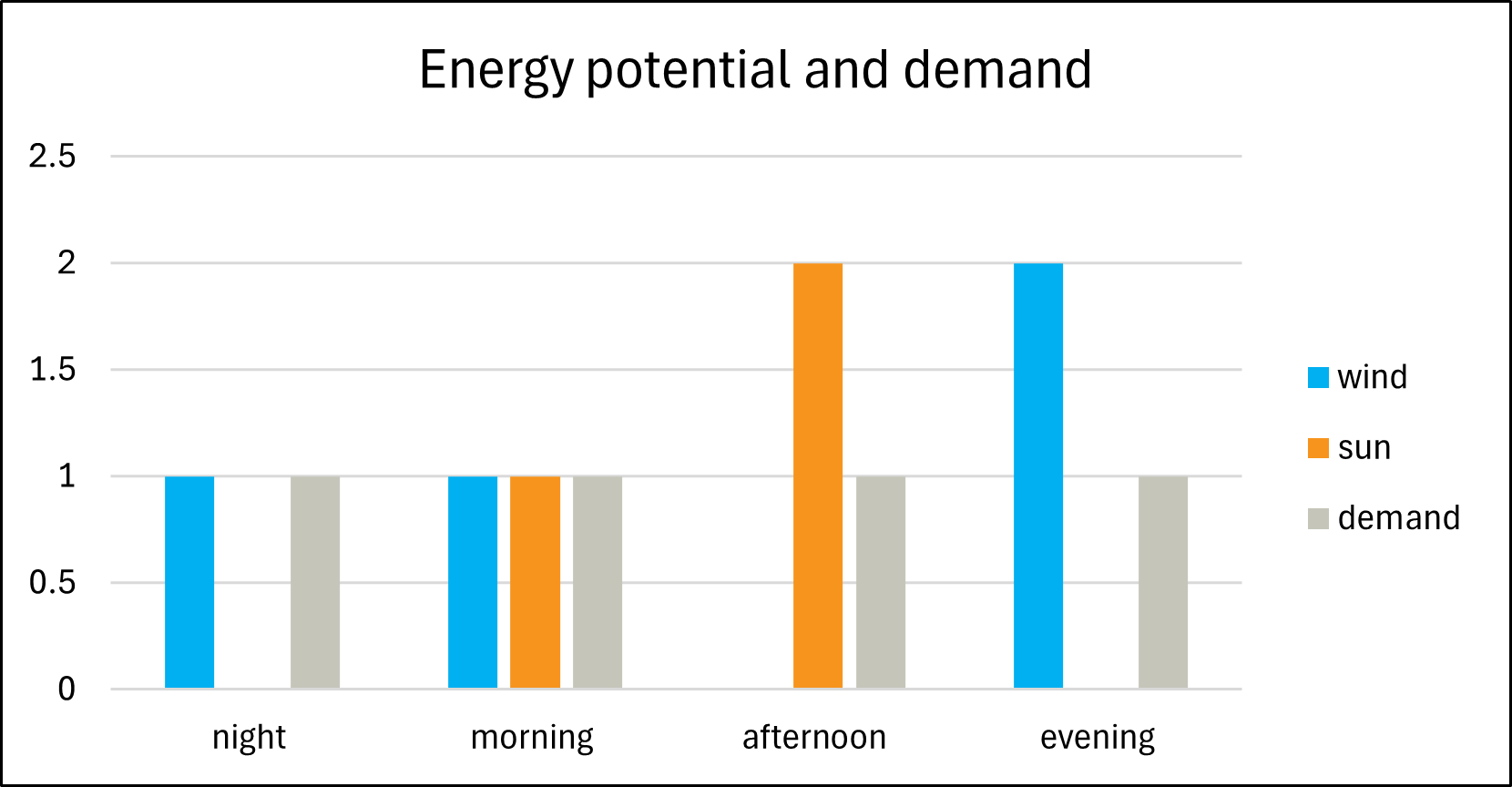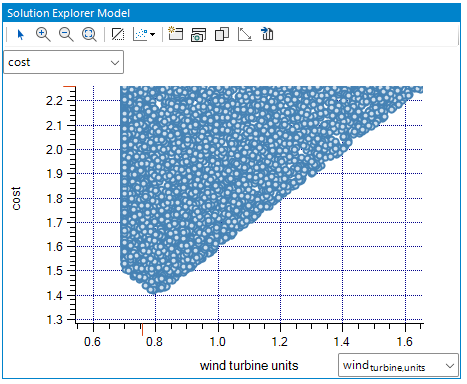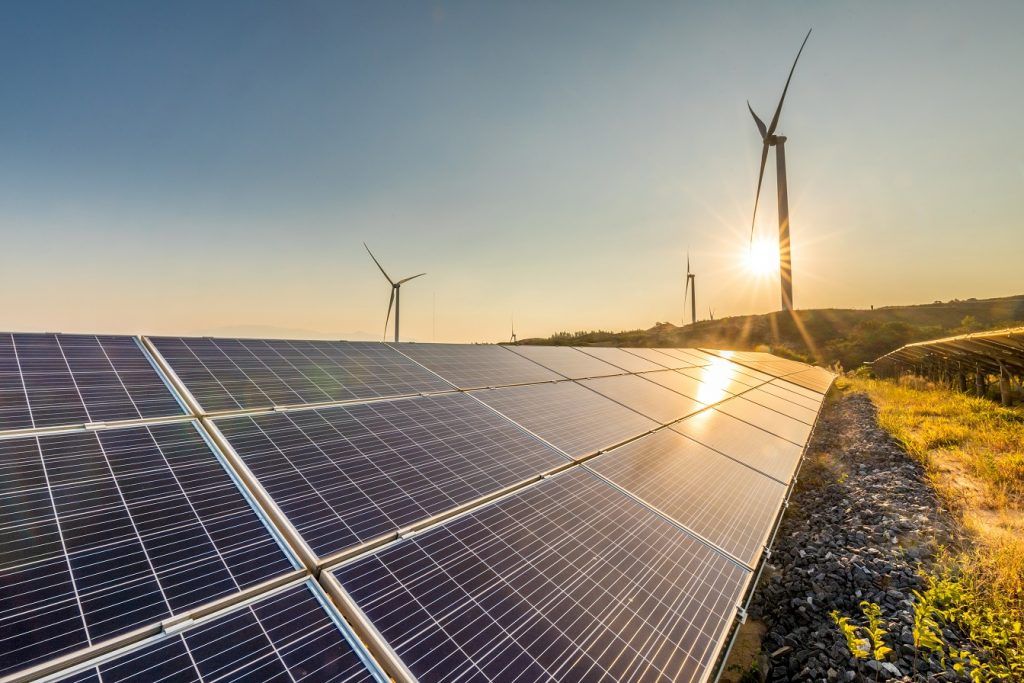The energy transition is not just about green electricity to replace fossil-based electricity. Industrial use of fossil fuels must also be addressed, and the popular candidate to replace fossil fuels is hydrogen. Since many industrial processes cannot be stopped and started quickly, this requires a steady supply of hydrogen for industry. Hydrogen can be generated from green electricity. Sun and wind are plentiful sources, but they are variable. How can we match the variable supply to the constant demand?
In a series of Reden Makes Sense columns, we present results for a combined offshore wind/solar park with batteries and hydrogen generators. The work is done in collaboration with Fluor BV. We made a model that finds complete solutions (number of wind turbines, number of solar panels, battery capacity, hydrogen storage capacity, electrolyser dimensions, etc., for a few scenarios. Realistic data for the installations were used. Weather data from KNMI is used to predict the supply of renewable energy (solar and wind).
The aim is to find the best set-up (wind turbines, solar panels, storage of electricity, storage and conversion equipment for hydrogen) which guarantees a steady supply of hydrogen. The installation is to be stand-alone without input or output of electricity from/to the grid.
Introduction
Three things dominate the plans for the Energy Transition: Sun, Wind, and Hydrogen. They conjure up dreams of a carefree world where the energy and the climate problem have been solved [1]. Solar and Wind are the free sources of energy, and Hydrogen is the super power enabling fossil-fuel-free industry and transport. However, there are some problems. Wind and Sun are variable and unpredictable. In bright sunshine and a fresh breeze, the electric power output from solar cells and wind turbines is very high, but in a calm night, the output is zero. Industrial processes, on the other hand, cannot be stopped and started easily and require a continuous energy supply. Hydrogen isn’t as convenient as current industry fuels, when it comes to keeping some of it in stock. It has a low energy density (less than one third of that of methane, at the same pressure and temperature), and cannot be liquified [2], so it must be compressed for transport and storage.
In short, the three ingredients of the Energy Transition dream require some serious effort before they deliver the carefree energy future.
We investigate how wind, solar, batteries, and hydrogen storage can be combined to deliver a stable hydrogen supply from a stand-alone installation.

Setup
The situation is as follows. Somewhere, there is an energy park consisting of wind turbines and solar panels. The weather data recorded by a weather station at the location of the park are used as input for the energy generation potential of the wind turbines and the solar panels. There are batteries which can store electric energy, and there is an electrolysis plant to generate hydrogen. The modelling is done using Reves, the Reden package for design space exploration. The central question is: which installed peak power for wind turbines and solar panels, and which battery capacity is needed to enable a constant hydrogen output?

Initial analysis
The first variable is the location. At our latitude, an offshore location offers more wind, but solar panels are more problematic than onshore. An onshore location means having to buy land, but installation and maintenance are cheaper. A location in the tropics means more sun.
Whatever the location, sun and wind conditions vary over time. Wind can be totally absent for many hours or even days at a time. The sun is absent the whole night, and clouds may hide it during the day. As a consequence, potential for wind and solar energy varies from none (a night without wind) to very high (clear skies with strong winds). At 53 °N, the length of days varies between 7.5 and 17 hours, approximately, at 12 °N (the altitude of Bonaire), the day is between 11.5 and 13 hours long.
For a constant hydrogen supply, storage is very important. Depending on the weather conditions and on the installed wind and solar capacity, some long periods of insufficient wind and sun must be bridged. The large storage, in its turn, needs the installed electricity and hydrogen generating capacity to be much larger than necessary for the average hydrogen demand; the storage must be filled at the good times. A side effect will be that there will be periods when the energy generated is more than can be used for charging the batteries and generating hydrogen (unless a very large battery capacity is installed).

The model
To model the system for various settings, and find the relation between the installed equipment, the cost and the supply reliability, two powerful tools are used. The first is the Python programming language, the second Reden’s own design space exploration package Reves DSE.
Python code
Python is used to simulate the system for a given set of parameters. The wind and sun conditions for all periods of 10 minutes for a whole year are used to calculate the available solar and wind energy. There is a decision algorithm to determine whether the electric batteries should be charged or discharged, keeping the hydrogen generation system going as much as possible. If the hydrogen production is less than required, the hydrogen storage can be used; it should be filled whenever possible. The result of the simulation is, beside a number of informative graphs, the supply reliability (lower if there have been more or longer periods in which the hydrogen supply requirement could not be met) and the contractual cost of supply deficits.
Reves DSE
Reves DSE is used to generate possible sets of parameters (in particular the number of solar panels, and the number of wind turbines, the hydrogen storage capacity, the battery capacity and the hydrogen generation capacity) and to display the outcome of the simulation in clear interactive graphs.
Design choices
The basis of the study is the assumption that there is a market need for a stable hydrogen supply. If the supply is stable, then hydrogen can be used for industrial processes which run continuously. Since an uninterrupted stable supply is very important for such factories, the variability of the green energy sources is a challenge; the installed power must be a lot higher than the energetic demand, and there must be enough storage of electricity and hydrogen to bridge periods of low solar irradiation (to start with the nights!) and calm winds.
Scenarios
For comparison, three scenarios are analysed:
- Base case: solar and wind park at Twenthe Airport with storage and hydrolysis on sight. Delivery through pipes (at 60 bar pressure).
- Alternative 1: North Sea, close to Dutch coast. Only wind park, electrolyser and storage on land. Delivery at 60 bar through pipes.
- Alternative 2: as 1, but in Bonaire. Different weather data.
All scenarios are for a hydrogen supply of 1875 kg/h (requiring electrical input to the electrolyser of 100 MW)
The results for these scenarios will be given in the next part of this series. The model results are based on a large number of realistic data about the installation, and can be used to make design decisions based on costs and benefits.
It is always a good idea to get a feel of the problem before embarking on the full model with all complications and refinement. This is why we start with a much simpler case, which is not, in itself, useful, but may give useful insights. The results are not directly useful for the problem, but they help to understand the situation. The initial exercise is to look at a single day, with only four weather data points (night, morning, afternoon, evening). The aim is to find a combination of solar cells, wind turbines and electric batteries to enable a constant electricity supply (for a constant hydrogen generation) for this one day.

Initial exercise: a simple case: four periods
The simplest case which still has essentially the same features as the real problem is the hypothetical case that all days are the same. There are four periods (night, morning, afternoon, evening), each with its own wind and solar radiation strength. Of course, there is no sun in evening and night. There is only electricity storage in a battery, and the demand of hydrogen is constant, so a constant electricity supply is required.
We have to assume the number of wind turbines, the number of solar panels and the capacity of the batteries. Instead of real numbers, we have units of wind strength, units of solar radiation and units of battery storage:
- One unit of wind turbines can generate one unit of electric power if the wind strength is one.
- One unit of solar cells can generate one unit of electric power if the solar strength is one.
- One unit of battery storage can store the energy needed to supply one unit of electric power during one part of the day.
An example of the weather data and demand for a hypothetical day is given in the table and the graph.

The demand (1+1+1+1) can be met with one unit of wind turbines (delivering 1+1+0+2), but only if a battery with a capacity of 1 unit is included to bridge the calm afternoon (see graph above). The battery is full at midnight. It is not needed in the night and morning, but is used fully in the afternoon, when there is no wind.
With solar cells only, the demand can be met with 4/3 units of solar cells. In that case, a battery with capacity 2 is needed to bridge the dark evening and night. The battery (now twice as big!) is half full at midnight, is emptied during the night and charged in the morning and afternoon. At the end of the evening, it is again half full.
The optimisation problem is to find the cheapest combination of wind turbines, solar cells and battery that can give a stable supply.
For simplicity, we assume the cost of one unit of turbines, one unit of solar park and one unit of storage is the same.

The best solution can be found easily using Reves DSE. Once the rules are implemented, in particular that the battery can never be more full than 100%, and never ‘more empty’ than 0%, and that the supply should always be met, Reves can generate many solutions. If these are plotted against cost, the minimum can be selected:
- wind turbines: 0.8 units
- solar cells: 0.4 units
- batteries: 0.2 units


The combination of wind turbines and solar cells works so well that only a small battery is needed, for this particular, hypothetical case.
The cost is 0.8 + 0.4 + 0.2 = 1.4
This is indeed lower than the ‘wind only’ solution (cost 1 + 1 = 2) and the ‘solar only’ solution (cost 4/3 + 2 = 3.33)
The lowest cost solution without a battery is: wind 1 unit, solar 0.5 unit (cost 1+0.5 = 1.5).
For this hypothetical case, the conclusion would be that a combination of wind and solar energy is better than just wind or just solar, and that the use of a battery makes the solution cheaper.
Is this set-up also the best if the weather is uncertain, and changes day to day and season to season? How can you find the optimal set up for a more complicated system, with real climate data, where installations need time to start, and have conversion losses? This will be outlined in a coming Reden Makes Sense column.




